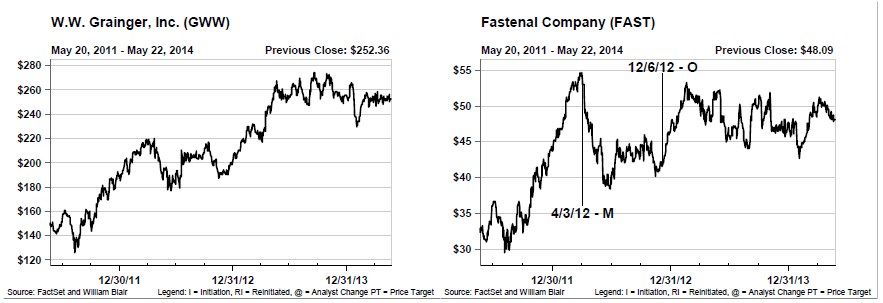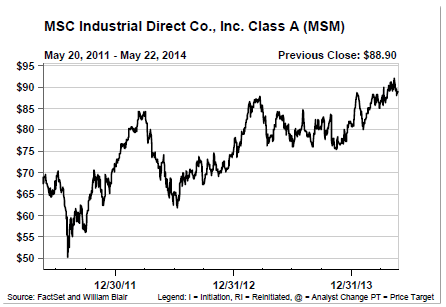Equity Research
Global Industrial Infrastructure | Industrial Distribution
Industrial Distribution
Expert Interview: Winning in the Evolving Industrial Distribution Landscape
May 22, 2014
Overview. We recently spoke with Jim Tompkins of Tompkins International about the evolving state of the industrial distribution landscape. Our goal was to better understand current trends in the industrial distribution space and who is best positioned to benefit. Tompkins International provides distribution operations, global supply-chain services, and growth and business strategy consulting. Mr. Tompkins has 35 years of consulting experience and has recently focused on the threat that an evolving marketplace, including e-commerce, poses to the traditional brick-and-mortar distribution model.
Large players likely to put mom-and-pops out of business en masse. According to Mr. Tompkins, industrial distribution is undergoing an evolution driven by seven pillars of change: 1) online success, 2) technology, 3) social commerce, 4) youth culture, customer service, 6) branch relevance, and 7) getting local. Mr. Tompkins believes the future of MRO distribution rests with companies that are willing to innovate and be relevant to the new buyer (who is younger and Internet savvy) and online marketplace. Gradually, the traditional MRO buyer, who valued a print catalog and baseball tickets, is dying. Size alone will not be enough for survival, nor will great technical expertise. Mr. Tompkins sees the future of MRO distribution dominated by several large broadline players and a few specialists who can “go deep” in a single category (think fasteners, metalworking, and bearings). Mr. Tompkins’s view is that large, well-capitalized distributors will put hundreds of thousands of mom-and-pops out of business during the next 10 years. Mr. Tompkins agreed with our view that Grainger is a greater threat to the mom-and-pops than other big B2B online players because Grainger can marry technology, service-minded salespeople, technical advice, and a multi-channel model into one defensible package. Already, we are seeing smaller players decide to get out of the inventory-stocking game and focus instead on technical selling, which increasingly is their only source of competitive advantage.
Seven Tipping Points of Industrial Disrtibution
-
Online Success
-
Technology
-
Social Commerce
-
Youth Culture
-
Customer Service
-
Branch Relevance
-
Get Local
Source: Tompkins International
Please see the following pages for more details.
Ryan Merkel, CFA
+1 312 364 8603
rmerkel@williamblair.com
David Mandell, CFA
+1 312 364 5197
dmandell@williamblair.com
W.W. Grainger, Inc.
Symbol: GWW (NYSE)
Price: $252.15 (52-Wk.: $228-$276)
Stock Rating: Outperform
Company Profile: Established Growth
Fastenal Company
Symbol: FAST (NASDAQ)
Price: $48.12 (52-Wk.: $42-$53)
Stock Rating: Outperform
Company Profile: Established Growth
MSC Industrial Direct Co., Inc.
Symbol: MSM (NYSE)
Price: $89.27 (52-Wk.: $75-$93)
Stock Rating: Outperform
Company Profile: Core Growth
Please consult pages 4-6 of this report for all disclosures. Analyst certification is on page 4.
William Blair & Company, L.L.C. does and seeks to do business with companies covered in its research reports. As a result, investors should be aware that the firm may have a conflict of interest that could affect the objectivity of this report. Investors should consider this report as a single factor in making an investment decision.
Where is MRO distribution going? Tompkins International’s January 2013 white paper, “Industrial Distribution at a Crossroads,” highlighted customers’ desire for multi-channel suppliers as a key success factor in MRO distribution. It is critical that distributors service customers under their own terms-how, when, and where. To meet this bar, Mr. Tompkins believes industrial distributors must be interactive, educational, engaging, and personalized in the sales and service approach. Customers have taken a closer look at their entire cost structure (including indirect costs) and are demanding more from suppliers of all sizes. To meet increased customer demands, distributors must be willing to adapt to how customers make purchases. For example, Grainger can customize its e-commerce tools to align with individual-customer buying workflows. His opinion is that where most competitors will struggle is exactly this type of collaboration among all the different customer demands. Remember, every customer has different processes and procedures for buying products. A multi-channel approach makes purchasing more convenient, allows the customer to personalize the experience, and provides different levels of “touch” depending on the technical nature of an order.
E-commerce has become an increasingly important part of the distributor value proposition as customer buying behavior has shifted. Large public distributors have invested heavily to create world-class e-commerce capabilities, and the entrance of giant online retailers also playing in the online B2B space has only brought further attention to the channel. Although existing online B2C and now B2B companies might be a threat to the large public incumbents, specifically through increased price transparency and usability of its website, the low-price and low-service online business model is not new to MRO distribution. In fact, Grainger has invested heavily in Zorotools.com to compete with other Web-only models. Zoro Tools offers more than 400,000 products at super low prices, according to its website. Zoro Tools offers no discounting or services and is tailored to small and medium customers who just want a fast transaction. Zoro Tools uses the same supply chain as the name-brand Grainger.com. We note that the Google reviews of Zoro Tools are excellent and that Zoro Tools has delivered more than 100% sales growth in recent periods.
What does “get local” mean? People want things faster. Even with the increasing importance of a multi-channel approach, getting local is the real key to success. Customers’ expectations for delivery time are being shortened-falling on a matrix depending on product function, customer size, and customer location. Mr. Tompkins has found that the largest customers in top- 40 metro areas expect the shortest delivery times from suppliers. Customers are willing to pay a premium for same-day delivery of certain products but are unwilling to incur shipping costs for lower-priority products. This means distributors must have: 1) the right inventory held locally, 2) local delivery capabilities, and 3) an understanding of where products are being delivered (i.e., end-user, warehouse, or home). Being local allows distributors to provide superior services in an increasingly just-in-time world. Fastenal’s extensive branch footprint, large salesforce, and proprietary distribution network have grown around the advantages of being local. Grainger’s multi-channel model addresses the need to be local and the recent push of territory sales representatives (TSRs) highlights the importance of being near the customer in the MRO business.
Mr. Tompkins used AutoZone (AZO $541.66) as an example of getting local. Every day, AutoZone has its local delivery fleet running products over to repair shops. Mechanics are unwilling to waste time picking up supplies and would rather pay a premium for just-in-time delivery. Also, AutoZone delivery and counter guys know a lot about the products they sell. No one can provide better “A-to-B” delivery than UPS (UPS $101.66; Outperform) and FedEx (FDX $139.33; Outperform) when it comes to long distances. However, within a single metropolitan area, distributors can deliver product more efficiently, similar to AutoZone, Fastenal, and Grainger. The key is to have the right local inventory and service-minded personnel to flex this advantage.
Full-line players will win out. Mr. Tompkins believes that full-line distributors will eventually win out because they carry the A-Z products customers need to maintain facilities. Grainger and similar B2B online players are well positioned and will put smaller competitors out of business, but not one another. Mr. Tompkins has been impressed with Grainger’s execution and believes it is the biggest threat to the mom-and-pops. Full-line distributors benefit from selling high-volume SKUs as well as slower-turning specialty items that require technical support. Relationships are also very important in the B2B world, and displacing existing high-service distributors is even difficult for the large public distributors that offer a better value.
Room for category specialists. Although the future of MRO distribution will be dominated by full-line players, there is room for strong specialists. Mr. Tompkins believes that the old model of selling technical expertise in one product category bundled with commodity products is no longer viable. Instead, the commodity products will go to larger players (which have better pricing and service). Specialists could struggle as the technical products they sell might not create enough volume without the commodity products, too. This type of competitor is best suited to sell its product knowledge on its own through consulting rather than through stocking inventory. To survive, mom-and-pop specialists will have to be so strong in a long-tail product category (such as bearings) that larger players see the barriers to entry as too large. To achieve scale while focusing on a narrow product set, a specialty distributor will need national coverage to create sustainable scale. Although Fastenal and MSC Industrial are becoming broader in their product offerings, we view their scale and expertise in the fastener and metalworking categories as continued anchors for their success (even between each other).
Finding value in the branch model-being local with a purpose. The evolution of MRO distribution to a multi-channel service model has meant more emphasis on e-commerce and reduced dependence on branches. How has Grainger changed since its e-commerce business has taken off? It has closed branches, increased SKUs, hired more general salespeople and more sales specialists, and added more services. Branch networks will need to be justified as a value-add destination for customers or a critical point in a distributor’s supply chain-so, they will need to be local with a purpose. No longer can a branch be a place to cultivate relationships over doughnuts. Put another way, why would you go to Staples when you can buy paper online? The changing role of branches has already been recognized by Grainger. Grainger is removing slow-turning inventory from its showrooms and adding work tables for associates to troubleshoot customer problems. The new branch model is more of an “industrial apple” and lends itself to the consultative relationship that Grainger wants to form with its customers. Although evolving, branches will not disappear because customers find comfort in the local inventory and service as a part of the multi-channel model.
Although Fastenal has slowed its branch rollout over the past five years, the network remains a critical part of its strategy. The facilities provide salespeople with a location to work from and offer local inventory of customer-specific SKUs. The branches are also the final point in Fastenal’s supply chain. Unlike other distributors who use FedEx or UPS, Fastenal operates its own supply-chain transportation. Having a network of over 2,600 branches allows Fastenal to provide customers with same-day service.
As the industry evolves, core value proposition does not change. Even with the industry undergoing a rapid evolution, the core value-add of distribution has not changed. Consistently having the right product in the right place at the right time will win customer loyalty-delivery just needs to be faster today and the ordering process needs to be easier. Distributors must understand changes to customer buying preferences and align their selling and operational infrastructure accordingly. Below we highlight Tompkins International’s five pillars of industrial distribution success, which are applicable across all channels. As customers increasingly scrutinize all purchasing decisions and the purchasing managers become more Internet savvy, these five points of competitive differentiation are becoming more important.
Five Pillars of Industrial Distribution Success
-
Competitive Prices
-
Product Breadth
-
Availability
-
Speed of Delivery
-
Technical Support
Source: Tompkins International
Jim Tompkins is CEO of Tompkins International. He has written or contributed to more than 30 books and writes the Creating Supply Chain Excellence blog. He can be reached at jtompkins@tompkinsinc.com.
IMPORTANT DISCLOSURES
William Blair and its affiliates beneficially own or control (either directly or through its managed accounts) 1% or more of the equity securities of Fastenal Company as of the end of the month ending not more than 40 days from the date herein.
William Blair is a market maker in the security of Fastenal Company and MSC Industrial Direct Co., Inc. and W.W. Grainger, Inc. and may have a long or short position.
William Blair intends to seek investment banking compensation in the next three months from Fastenal Company and MSC Industrial Direct Co., Inc. and W.W. Grainger, Inc.
Additional information is available upon request.
This report is available in electronic form to registered users via R*Docs at www.rdocs.com or www.williamblair.com.
Please contact us at +1 800 621 0687 or consult williamblair.com/Research-and-Insights/Equity-Research/Coverage.aspx for all disclosures.
Ryan Merkel attests that 1) all of the views expressed in this research report accurately reflect his/her personal views about any and all of the securities and companies covered by this report, and 2) no part of his/her compensation was, is, or will be related, directly or indirectly, to the specific recommendations or views expressed by him/her in this report. We seek to update our research as appropriate, but various regulations may prohibit us from doing so. Other than certain periodical industry reports, the majority of reports are published at irregular intervals as deemed appropriate by the analyst.
DOW JONES: 16,533.06
S&P 500: 1,888.03
NASDAQ: 4,131.54


Current Rating Distribution (as of 04/30/14)
| Coverage Universe | Percent | Inv. Banking Relationships* | Percent |
|
Outperform (Buy) |
66 |
Outperform (Buy) |
14 |
|
Market Perform (Hold) |
31 |
Market Perform (Hold) |
2 |
|
Underperform (Sell) |
1 |
Underperform (Sell) |
0 |
*Percentage of companies in each rating category that are investment banking clients, defined as companies for which William Blair has received compensation for investment banking services within the past 12 months.
The compensation of the research analyst is based on a variety of factors, including performance of his or her stock recommendations; contributions to all of the firm’s departments, including asset management, corporate finance, institutional sales, and retail brokerage; firm profitability; and competitive factors.
OTHER IMPORTANT DISCLOSURES
Stock ratings, price targets, and valuation methodologies: William Blair & Company, L.L.C. uses a three-point system to rate stocks. Individual ratings and price targets (where used) reflect the expected performance of the stock relative to the broader market (generally the S&P 500, unless otherwise indicated) over the next 12 months. The assessment of expected performance is a function of near-, intermediate-, and long-term company fundamentals, industry outlook, confidence in earnings estimates, valuation (and our valuation methodology), and other factors. Outperform (O) – stock expected to outperform the broader market over the next 12 months; Market Perform (M) – stock expected to perform approximately in line with the broader market over the next 12 months; Underperform (U) – stock expected to underperform the broader market over the next 12 months; not rated (NR) – the stock is not currently rated. The valuation methodologies used to determine price targets (where used) include (but are not limited to) price-to-earnings multiple (P/E), relative P/E (compared with the relevant market), P/E-to-growth-rate (PEG) ratio, market capitalization/revenue multiple, enterprise value/EBITDA ratio, discounted cash flow, and others.
Company Profile: The William Blair research philosophy is focused on quality growth companies. Growth companies by their nature tend to be more volatile than the overall stock market. Company profile is a fundamental assessment, over a longer-term horizon, of the business risk of the company relative to the broader William Blair universe. Factors assessed include: 1) durability and strength of franchise (management strength and track record, market leadership, distinctive capabilities); 2) financial profile (earnings growth rate/consistency, cash flow generation, return on investment, balance sheet, accounting); 3) other factors such as sector or industry conditions, economic environment, confidence in long-term growth prospects, etc. Established Growth (E) – Fundamental risk is lower relative to the broader William Blair universe; Core Growth (C) – Fundamental risk is approximately in line with the broader William Blair universe; Aggressive Growth (A) – Fundamental risk is higher relative to the broader William Blair universe.
The ratings, price targets (where used), valuation methodologies, and company profile assessments reflect the opinion of the individual analyst and are subject to change at any time.
Our salespeople, traders, and other professionals may provide oral or written market commentary or trading strategies-to our clients and our trading desks-that are contrary to opinions expressed in this research. Certain outstanding reports may contain discussions or investment opinions relating to securities, financial instruments and/or issuers that are no longer current. Always refer to the most recent report on a company or issuer before making an investment decision. Our asset management and trading desks may make investment decisions that are inconsistent with recommendations or views expressed in this report. We will from time to time have long or short positions in, act as principal in, and buy or sell the securities referred to in this report. Our research is disseminated primarily electronically, and in some instances in printed form. Electronic research is simultaneously available to all clients. This research is for our clients only. No part of this material may be copied or duplicated in any form by any means or redistributed without the prior written consent of William Blair & Company, L.L.C.
THIS IS NOT IN ANY SENSE A SOLICITATION OR OFFER OF THE PURCHASE OR SALE OF SECURITIES. THE FACTUAL STATEMENTS HEREIN HAVE BEEN TAKEN FROM SOURCES WE BELIEVE TO BE RELIABLE, BUT SUCH STATEMENTS ARE MADE WITHOUT ANY REPRESENTATION AS TO ACCURACY OR COMPLETENESS OR OTHERWISE. OPINIONS EXPRESSED ARE OUR OWN UNLESS OTHERWISE STATED. PRICES SHOWN ARE APPROXIMATE.
THIS MATERIAL HAS BEEN APPROVED FOR DISTRIBUTION IN THE UNITED KINGDOM BY WILLIAM BLAIR INTERNATIONAL, LIMITED, REGULATED BY THE FINANCIAL CONDUCT AUTHORITY (FCA), AND IS DIRECTED ONLY AT, AND IS ONLY MADE AVAILABLE TO, PERSONS FALLING WITHIN COB 3.5 AND 3.6 OF THE FCA HANDBOOK (BEING “ELIGIBLE COUNTERPARTIES” AND “PROFESSIONAL CLIENTS”). THIS DOCUMENT IS NOT TO BE DISTRIBUTED OR PASSED ON TO ANY “RETAIL CLIENTS.” NO PERSONS OTHER THAN PERSONS TO WHOM THIS DOCUMENT IS DIRECTED SHOULD RELY ON IT OR ITS CONTENTS OR USE IT AS THE BASIS TO MAKE AN INVESTMENT DECISION.
“William Blair” and “R*Docs” are registered trademarks of William Blair & Company, L.L.C. Copyright 2014, William Blair & Company, L.L.C. All rights reserved.


